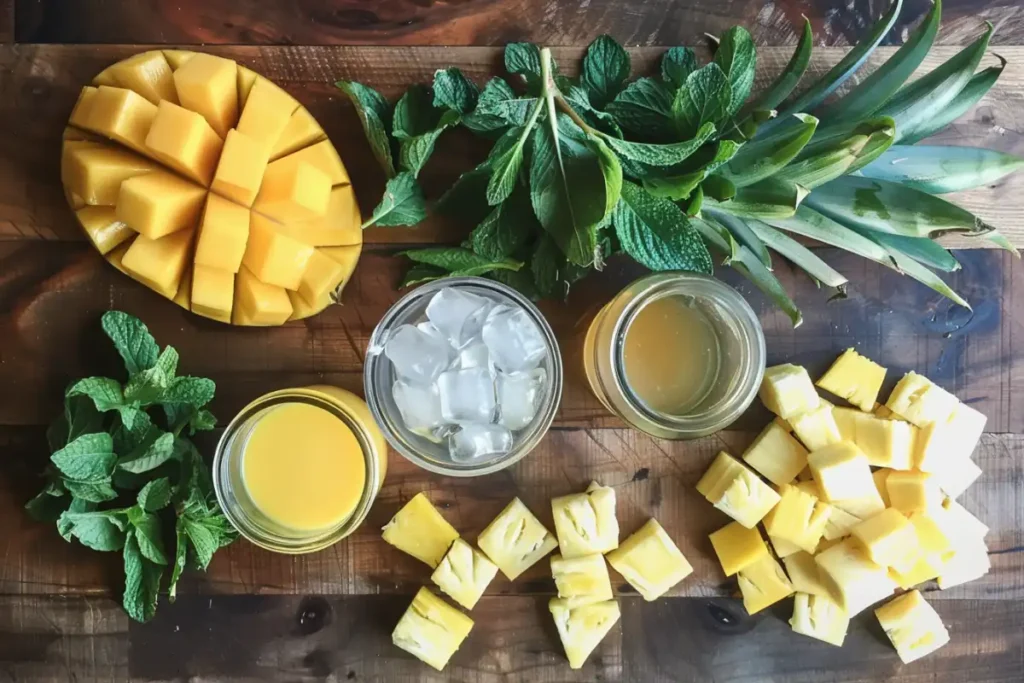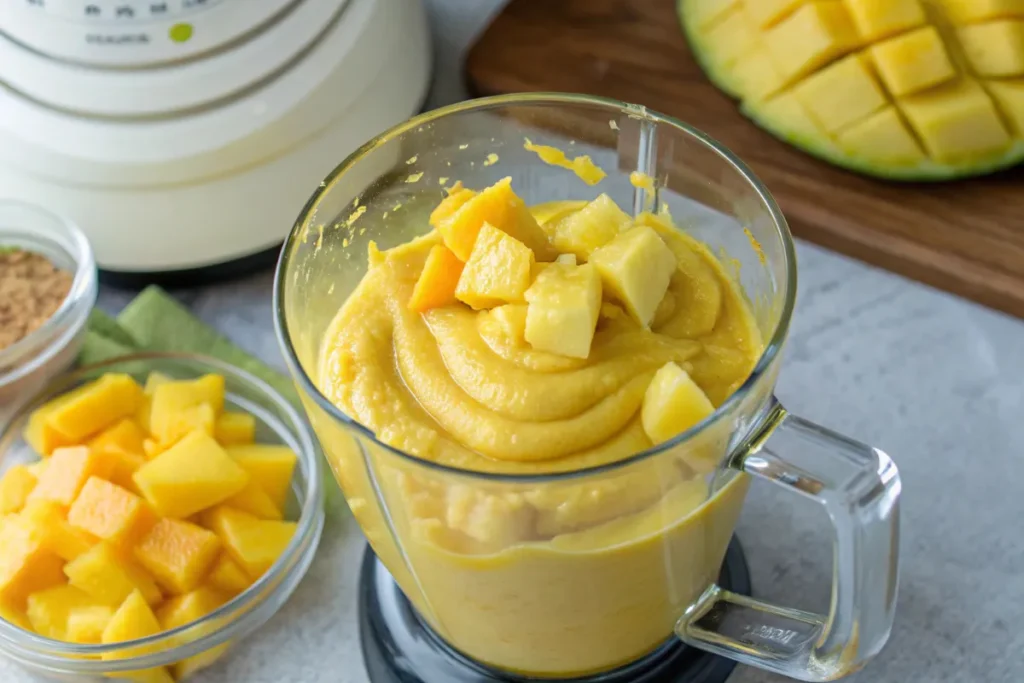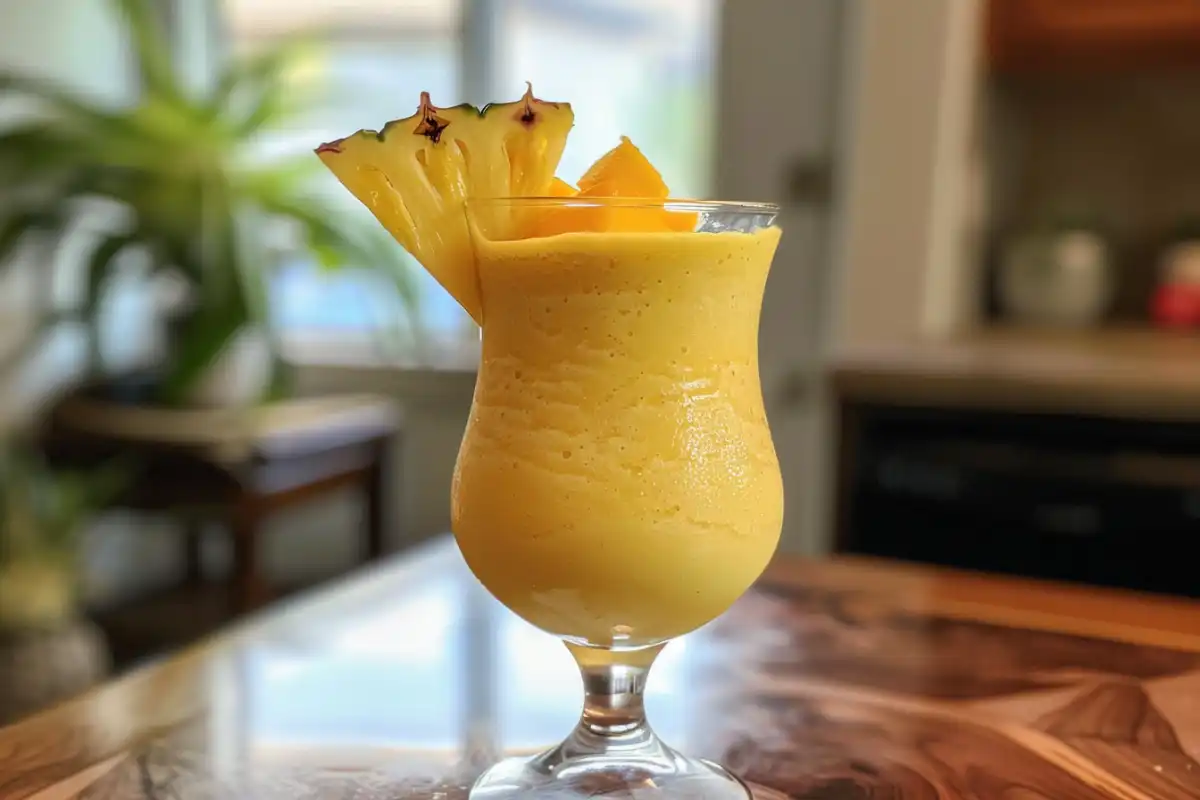A mango pineapple smoothie No milk is the ultimate refreshing tropical treat that can be enjoyed any time of day. Whether you’re savoring it as a quick breakfast, an energizing post-workout drink, or simply a cooling snack on a hot day, this smoothie delivers in both flavor and texture. One of the best things about this smoothie is that it doesn’t need milk, making it perfect for those who are lactose-intolerant, vegan, or just looking for a lighter option.
This guide will walk you through making a perfect mango pineapple smoothie no milk, exploring multiple variations, including smoothie bowls, protein-packed versions, and additional ways to customize your smoothie.
Table of Contents
Why Choose a Mango Pineapple Smoothie No Milk?
There are many reasons why you might want to enjoy a mango pineapple smoothie no milk:
- Lighter Texture: By using water, coconut water, or juice as your liquid base, you keep the smoothie light and refreshing without making it too thick or heavy.
- Dairy-Free and Vegan: A smoothie without milk is a fantastic option for those who need to avoid dairy, whether due to lactose intolerance or for ethical reasons. Many people also find this smoothie easier to digest.
- Tropical Flavors Take the Spotlight: By eliminating milk or yogurt, the fresh, vibrant flavors of the mango and pineapple truly shine through. You can fully appreciate the natural sweetness of these fruits without any interference from dairy.
Essential Ingredients for Mango Pineapple Smoothie No Milk

A mango pineapple smoothie no milk is a very simple recipe with only a few key ingredients. Here’s what you’ll need to make it:
1. Mango
The star of this mango pineapple smoothie no milk , mango adds sweetness, creaminess, and a beautiful golden hue to the drink. You can use either fresh or frozen mango depending on what’s available.
2. Pineapple
Pineapple contributes a tart, tangy flavor that balances the sweetness of the mango, creating a perfectly harmonious taste. Like mango, you can use fresh or frozen pineapple. Fresh pineapple adds brightness to the smoothie, while frozen pineapple helps achieve a thicker consistency.
If you need guidance on preparing fresh pineapple, refer to this tutorial on cutting pineapple to ensure you're slicing it correctly.
3. Liquid Base
Because this smoothie doesn’t use milk, you’ll need a liquid to help blend the fruit. Your options include:
- Water: Keeps the smoothie light, simple, and hydrating.
- Coconut Water: Adds a mild tropical flavor that enhances the mango and pineapple.
- Fruit Juice: Using pineapple or orange juice boosts the fruitiness and sweetness of the smoothie.
Start with 1/2 to 1 cup of liquid, and adjust depending on the thickness you prefer.
4. Ice (Optional)
If you’re using fresh fruit, consider adding ice to the blender to cool and thicken the smoothie. If you’re using frozen fruit, ice isn’t necessary.
5. Sweetener (Optional)
Depending on the ripeness of your fruit, you may not need any additional sweetener. However, if you’d like your smoothie to be sweeter, natural sweeteners like honey, maple syrup, or agave can be added. Often, the natural sugars in mango and pineapple are enough to keep the smoothie sweet and delicious without any extra sugar.
For a delicious pairing, enjoy this refreshing Mango Pineapple Smoothie no milk with warm and fluffy Sourdough Cinnamon Rolls. The tropical flavors and cozy spices complement each other perfectly!
Mango Pineapple Smoothie No Milk Recipe

Now that you have your ingredients, let’s make the perfect mango pineapple smoothie no milk. This simple, step-by-step guide will help you create a creamy, refreshing drink in just a few minutes.
Step 1: Prepare the Fruit
- Mango: If using fresh mango, peel the skin, remove the pit, and chop it into small chunks. If using frozen mango chunks, you can add them directly to the blender.
- Pineapple: For fresh pineapple, peel, core, and slice it into chunks. If using frozen pineapple, you can add it straight to the blender without thawing.
Step 2: Add the Liquid
Pour in your choice of liquid—whether it’s water, coconut water, or fruit juice. Start with 1/2 cup and adjust as needed. If you prefer a thicker smoothie, add less liquid; for a thinner consistency, add more.
Step 3: Blend the Ingredients
Place your fruit, liquid, and optional sweetener (if using) into the blender. Blend on low speed at first, gradually increasing to high until the mixture is smooth and creamy. If you prefer your smoothie thicker, add more fruit or ice; if it’s too thick, add a bit more liquid and blend again.
Step 4: Taste and Adjust
Once blended, taste the smoothie. Adjust the flavor or thickness as needed—whether adding a little more sweetener, a splash more liquid, or a few extra chunks of fruit.
Step 5: Serve and Enjoy
Pour your smoothie into a glass or bowl, add any desired toppings (like coconut flakes or fresh berries), and enjoy!
For a more filling meal, pair your mango pineapple smoothie no milk with a hearty dish like this Steak, Egg, and Cheese Bagel, balancing the fruity freshness of the smoothie with savory flavors.
Mango Pineapple Smoothie Variations
One of the best things about making a mango pineapple smoothie no milk is that it’s incredibly versatile. You can easily adapt it to suit your preferences or nutritional needs by swapping ingredients or adding new ones. Here are some delicious variations:
1. Mango Pineapple Smoothie with Coconut Water
For an extra tropical flavor, coconut water is an excellent replacement for regular water. It provides subtle coconut notes that perfectly complement the mango and pineapple.
- How to Make It: Follow the original recipe but swap water or juice for coconut water. This keeps the smoothie light and refreshing, with a hint of coconut.
2. Mango Pineapple Green Smoothie
Add leafy greens like spinach or kale for a green smoothie without altering the delicious tropical flavor. Spinach and kale blend smoothly into the drink, giving you a nutrient boost without affecting the taste.
- How to Make It: Add a handful of spinach or kale to the blender along with the fruit. You may need to add a little extra liquid to help the greens blend smoothly.
3. Mango Pineapple Smoothie Bowl
Turn your mango pineapple smoothie no milk into a fun, customizable smoothie bowl by reducing the amount of liquid. Smoothie bowls are thicker and can be topped with a variety of delicious add-ins like granola, coconut flakes, and fresh fruit.
- How to Make It: Use less liquid (about 1/4 to 1/2 cup) to make a thicker smoothie that can be scooped into a bowl. Top with your choice of add-ins, such as sliced banana, chia seeds, or granola.
4. Mango Pineapple Protein Smoothie
For a post-workout recovery drink, you can add a scoop of protein powder to your mango pineapple smoothie. Vanilla or unflavored protein powders work best as they won’t overpower the tropical flavors of the fruit.
- How to Make It: Add one scoop of your preferred protein powder (whey, soy, or plant-based) to the blender. Blend until smooth, adding extra liquid if needed for consistency.
For a unique spin on the traditional mango pineapple smoothie, try adding a few fresh mint leaves. This not only enhances the tropical flavors but also adds a refreshing coolness to the drink.
Making a Smoothie Without a Blender
No blender? No problem! Here’s how to make a mango pineapple smoothie no milk without one:
- Mashing by Hand: Use a fork or potato masher, gradually mixing in liquid and sweetener for a refreshing, chunky smoothie.
- Food Processor: Blend fruit and liquid, scraping the sides as needed. Add extra liquid for a smoother texture.
For a delicious brunch, pair your mango pineapple smoothie no milk with a pancake cake, the tropical flavors complement the richness perfectly!
A mango pineapple smoothie no milk is a refreshing, tropical treat that can easily be adapted to suit your preferences. Whether you’re enjoying a simple smoothie, turning it into a smoothie bowl, or adding protein powder for a post-workout boost, this recipe is as versatile as it is delicious.
(FAQs)
Can I Make a Mango Pineapple Smoothie Without a Blender?
- Yes! Use a food processor for the best results or mash the fruit by hand for a chunkier texture.
What Liquid Can I Use Instead of Coconut Water?
- Swap it with pineapple juice, orange juice, or water for a different flavor twist.
Can I Store This Smoothie for Later?
- Yes, refrigerate in an airtight container for up to 24 hours. Stir before drinking as separation may occur.
How Can I Make My Smoothie Thicker?
- Use frozen fruit, ice, or half a banana for a thicker, creamier consistency.
What Toppings Work Best for a Smoothie Bowl?
- Try granola, coconut flakes, chia seeds, fresh fruit, or sliced bananas for added texture and flavor!
Mango Pineapple Smoothie (No Milk) Recipe
This Mango Pineapple Smoothie is a refreshing, dairy-free tropical drink made without milk! Bursting with natural sweetness and vibrant flavors, it’s the perfect healthy and hydrating smoothie for any time of day
- Prep Time: 5 minutes
- Total Time: 5 minutes
- Category: Drinks
- Method: Blender
Ingredients
For the Smoothie:
- 1 cup frozen mango chunks
- 1 cup frozen pineapple chunks
- 1 cup coconut water (or orange juice for extra sweetness)
- ½ banana (for creaminess, optional)
- ½ tbsp lime juice (optional, for a zesty touch)
- ½ tsp turmeric (optional, for an anti-inflammatory boost)
- Ice cubes (optional, for extra chill)
Instructions
-
Blend the Ingredients:
- In a blender, combine mango, pineapple, coconut water, banana (if using), and lime juice.
-
Blend Until Smooth:
- Blend on high for 30-45 seconds, until creamy and smooth.
-
Adjust & Serve:
- Add ice cubes if a thicker texture is desired.
- Pour into glasses and enjoy immediately!
Notes
- For extra protein, add 1 tbsp chia seeds or ½ cup Greek yogurt (if not dairy-free).
- For a tropical twist, replace coconut water with fresh coconut milk or passion fruit juice.
- For added sweetness, blend in 1-2 Medjool dates or a drizzle of honey.


